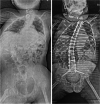Fourteen-year change in activities of daily living of a quadriplegic, ventilator-managed patient injured by high cervical spinal cord injury during infancy: a case report
- PMID: 36008853
- PMCID: PMC9414331
- DOI: 10.1186/s12887-022-03573-y
Fourteen-year change in activities of daily living of a quadriplegic, ventilator-managed patient injured by high cervical spinal cord injury during infancy: a case report
Abstract
Background: Rehabilitation of patients with high cervical spinal cord injury (CSCI) to improve activities of daily living (ADL) is challenging due to severe paralysis. In addition, pediatric patients with CSCI are rare, and literature describing ADL changes as the patient grows are limited. In this case report, we present the long-term change in ADL over time in a girl with severe high CSCI from an injury during infancy.
Case presentation: A 2 years and 6 months old girl, who was injured in a traffic accident, was diagnosed with C3 CSCI, resulting in complete quadriplegia and respiratory paralysis below C3. Thus, she was managed with a ventilator. Rehabilitation for quadriplegia, respiratory dysfunction, and autonomic neuropathy was started on the fifth day after the injury while she was in the intensive care unit. Six months after the injury, the patient was transferred to a hospital. Thereafter, she was discharged with nursing and care guidance provided to her family and environmental changes at home. Afterwards, she continued to acquire skills through writing training using a mouse stick, computer operation training, and electric wheelchair operation training, which enabled her to improve her ADL despite her severe disability. In terms of education, she was able to go through a regular elementary school, a regular junior high school, and then to a senior high school of a support school.
Conclusions: We believe that training that utilizes current technology and changes in the environment that are appropriate for daily life are important for improving the ADL of children with severe CSCI.
Keywords: ADL; Child; Disability; Electric Wheelchair; Functional Independence Measure; Quality of Life.
© 2022. The Author(s).
Conflict of interest statement
The authors declare that there is no conflict of interest.
Figures











Similar articles
-
Demographic and clinical characteristics of patients with traumatic cervical spinal cord injury: a Turkish hospital-based study.Spinal Cord. 2015 Jun;53(6):441-5. doi: 10.1038/sc.2014.211. Epub 2014 Dec 9. Spinal Cord. 2015. PMID: 25487242
-
Impact of energy intake on the activities of daily living in patients with cervical spinal cord injury undergoing post-acute rehabilitation.J Spinal Cord Med. 2024 Nov;47(6):832-839. doi: 10.1080/10790268.2023.2212333. Epub 2023 May 17. J Spinal Cord Med. 2024. PMID: 37195196 Free PMC article.
-
Pivotal Role of Cervical Rotation for Rehabilitation Outcomes in Patients with Subaxial Cervical Spinal Cord Injury.Neurochirurgie. 2020 Aug;66(4):247-251. doi: 10.1016/j.neuchi.2020.04.127. Epub 2020 Jun 12. Neurochirurgie. 2020. PMID: 32540343
-
Robot-assisted Therapy for the Upper Limb after Cervical Spinal Cord Injury.Phys Med Rehabil Clin N Am. 2019 May;30(2):367-384. doi: 10.1016/j.pmr.2018.12.008. Epub 2019 Mar 2. Phys Med Rehabil Clin N Am. 2019. PMID: 30954153
-
Oropharyngeal Dysphagia in Acute Cervical Spinal Cord Injury: A Literature Review.Dysphagia. 2023 Aug;38(4):1025-1038. doi: 10.1007/s00455-022-10535-0. Epub 2022 Nov 14. Dysphagia. 2023. PMID: 36374337 Free PMC article. Review.
Cited by
-
Ultrasound monitoring respiratory muscle rehabilitation training can promote the recovery of diaphragmatic function in traumatic spinal cord injury (TSCI) patients.Eur J Med Res. 2025 Aug 11;30(1):733. doi: 10.1186/s40001-025-03023-2. Eur J Med Res. 2025. PMID: 40790540 Free PMC article. Clinical Trial.
References
Publication types
MeSH terms
LinkOut - more resources
Full Text Sources
Medical
Miscellaneous

